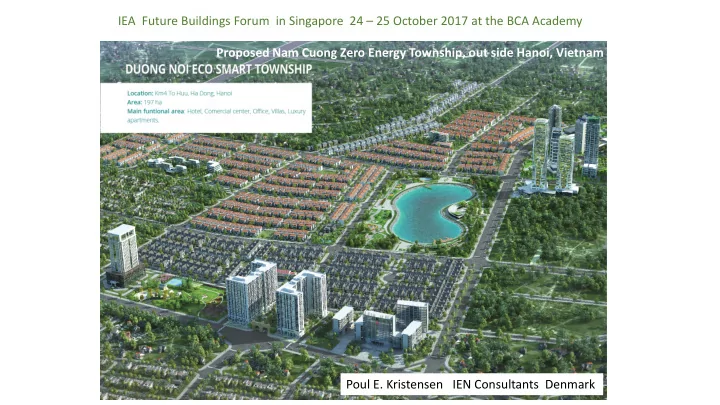

IEA Future Buildings Forum in Singapore 24 – 25 October 2017 at the BCA Academy Proposed Nam Cuong Zero Energy Township, out side Hanoi, Vietnam Poul E. Kristensen IEN Consultants Denmark
Poul E. Kristensen, Director IEN Consultants Hasselvej 30, 2830 Virum Denmark Research and development on energy efficiency and RE in buildings since 1977 (Joined IEA SHC Task 1 in 1978) 1977 – 2000 Working internationally out of Denmark 2001 – 2017 Working primarily in Malaysia and Vietnam 2001 – 2012 : MD of IEN Consultants, Kuala Lumpur Malaysia 2013 – 2017 : WB/IFC Hanoi -Senior Technical Adviser - “Vietnam Green Buildings Program” 2015– 2017 : UNDP/GEF International Technical Expert on EE in Buildings – “EE Improvement in Buildings in Viet Nam”
Zero Energy Townships in Vietnam, a Macro-Economic Perspective A Zero Energy Township is a township that produces all the energy needed in the township from renewable energy A combination of energy efficiency in buildings and use of renewable energy In the case of a Vietnamese township, the main energy technologies will be : Advanced technologies to reduce energy consumption in buildings : 50% savings Solar electricity and solar energy for heating of hot water : 25% savings Hydropower electricity imported from the electric grid : remainder 25% The NamCuong Zero Energy Township must be a Smart Electricity City Buildings are designed so that they have a reduced power consumption from the grid when local solar energy is not available, Import of electricity from the grid is reduced and happens only during off peak periods
Copenhagen has the ambition to become the 1 st Carbon Neutral Capital in the World By 2025 Reduce carbon emissions, create green growth, enhance quality of life.
Hydroelectricity covers around 20% of total electricity load. The Zero Energy Community can only draw 20% of normal electricity consumption ( kWh/year ) The Zero Energy Community should draw 0% of normal peak power ( kW )
Vietnam
Integration of Solar PV in the facades
Experiences with Energy Efficiency in Malaysia and Vietnam Ministry of Energy, Malaysia Energy Commission, Malaysia • Costs for going green : 2 – 5% extra construction costs • Saving on Energy Bill : 30 – 60% • Payback period for Green Buildings : 3 – 6 years FPT Building, Da Nang Vietnam Sarawak Energy HQ, Malaysia
Green Buildings are Cheaper than Grey Buildings 10.000 m 2 office building Electric Power Plant - 12% or 1.2 mio US$ + Savings on Energy Consumption ( 40 – 50% ) + Savings on CO 2 Emissions ( 40 – 50% )
Estimate of Energy Savings Potential for Domestic Buildings Preconditions so that new power plants are not needed The buildings can buy 20% electricity from EVN (Hydropower) The buildings must draw minimum power from the grid during peak hours ( 9.00 – 17.00 hours ) Market Survey, September 2012
Energy Efficient Buildings is the cheaper solution $ $ It is cheaper to build an Energy Efficient Building than to build power plants One MW saved in buildings is cheaper than one MW extra power plant capacity + we save on electricty costs for the comsumer + we save CO 2 emissions for the enviornment Effective Financial Instruments must be based on this economic reality
Proposed Nam Cuong Zero Energy Township, Hanoi, Vietnam Key prequisites for implementation : Saving MW´s is cheaper than building MW´s Cooperation with the utilities is critical ( EVN : Electricity of Vietnam ) Support by the Government of Vietnam : Ministry of Industry and Trade MOIT Technologies for energy efficiency and solar PV are technologically mature and financially competitive Recognition by the International Energy Agency can be most importrant for further progress Advanced technologies to reduce energy consumption in buildings : 50% savings Solar electricity and solar energy for heating of hot water : 25% savings Hydropower electricity imported from the electric grid : remainder 25%
Examples of Zero Energy Cities in the world Copenhagen , with 1. 2 million inhabitants, is striving to be the worlds first Zero Energy Capital by 2025 Around the world there are several initiatives to develop and demonstrate Zero Energy Townships. Some of these are : o Z-Net Uralla in Australia between Sydney and Brisbane is developing a Zero Energy Township o Crisfield’s community in Maryland US is developing a Zero Energy Township, primarily based on wind energy o Beddington Zero Energy Development (BedZED) north of London is an existing Zero Energy Township, based on solar electricity and biomass
Recommend
More recommend